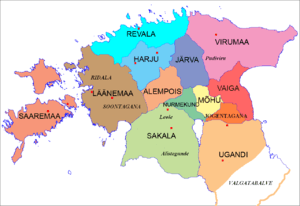Sakala County
| Sakala | |||||
| county of Ancient Estonia | |||||
| |||||
 | |||||
| Capital | Viljandi | ||||
| Elder | |||||
| • | c.1200–1217 | Lembitu | |||
| History | |||||
| • | Established | 9th Century | |||
| • | Disestablished | 1224 | |||
| Today part of | | ||||
Sakala County (Estonian: Sakala, Latin: Saccalia)[1] was an ancient Estonian county [2] first mentioned in print by Henry of Latvia in the beginning of the 13th Century.[3]
Geography
Sakala County is situated in north-western Livonia, covering approximately the present territories of Viljandi, the southern half of Pärnu, and a western third of Valga maakond. It was the southernmost of the ancient Estonian counties.
History
Kievan rule of Ugaunia, the country directly east from Sakala, may have lasted until 1061, when, according to Old East Slavic chronicles, the town of Tharbata/Yuryev (Tartu) was burned down by "Sosols", who were probably either Sackalians or the people of Soopoolitse.
After the Livonian Crusade the county became a part of the Livonian Confederation.
In Sackalian folklore, the neighbouring Ugaunians (ugalased) were enemy warriors and robbers. For instance, a folk song from Viljandi (the capital of Sackalia) calls for speeding up the harvest work because Ugaunians might attack.
See also
References
- ↑ Historical Dictionary of Estonia; p.63 ISBN 0-8108-4904-6
- ↑ p31, History of Estonia, 2nd Ed., Tõnu Tannberg, et al. AS Bit 2002, ISBN 9985-2-0606-1
- ↑ The Chronicle of Henry of Livonia ISBN 0-231-12889-4